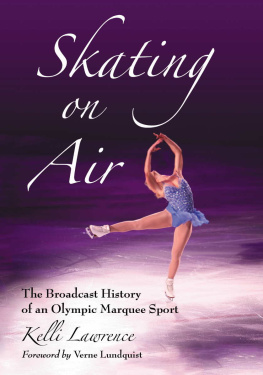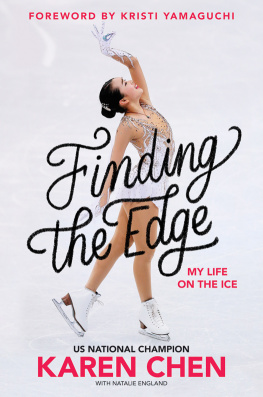PREFACE
Pair skating as a World Championship sport was first contested in 1908 in St. Petersburg, Russia, where three pairs from as many countries presented free-skating programs in a one-event competition. Anna Hbler and Heinrich Burger of Germany became the disciplines first World champions. Phyllis and James Johnson of Great Britain placed second, with A. L. Fischer and L. P. Popova of Russia third. Eight and a half months later, figure skating became the first winter Olympic sport at the Games of the Fourth Olympiad, held in London, with four disciplines contested: men, ladies, pairs, and special figures.
Competitions for pairs at two major skating events in 1908 seemed surprising to me because few references to pair skating exist in skating literature prior to that time. Contemporary books on skating had only recently begun describing figures that could be done by a pair. Further research revealed that a few pair skating events had been held at regional and inter-club competitions in Europe, but the discipline appeared to be outside the mainstream of competitive figure skating. This raised two questions: Why did the discipline surface so prominently in 1908, and what elements were included in those pair skating programs? A simple explanation cannot be provided for why the events were held, but a root cause is clearly the ever-increasing number of women who during the previous twenty-five years had become proficient skaters and wanted to compete, not just in singles but with partners as well. This book was originally intended to be a brief exploration into the beginning of pair skating, but the realization of its relationship to the role of women in the sport led to the conclusion that an expanded study with an emphasis on womens participation was warranted, related not just to pair skating but to the evolution of their role into one of prominence in figure skating overall.
A woman had stormed onto the competitive scene six years earlier. The skating world was stunned by the audacity of Madge Syers, a talented British skater who entered the 1902 World Championship held that year in London. Such an action had never been considered, and no rule disallowed women competitors. Syers placed second among the four contestants. Ulrich Salchow of Sweden, the reigning champion, won easily. Martin Gordan of Germany placed third; Horatio Torrom of Argentina, then living in London, placed fourth.
Women in competitive skating provided a hot topic of discussion at the next congress of the International Skating Union (ISU) in 1903, but because the subject had not been included on the agenda, gender-specific rules could not be adopted. The tone of the meeting, however, was clear: Women should be excluded from competing, at least against men. At the next biennial congress, in 1905, after extensive debate and strong lobbying by the National Skating Association of Great Britain, women were excluded from competing against men, but a championship for ladies was approved to be implemented in 1906. It was held at Davos, Switzerland, and Syers became the first lady champion. She won a second title the following year.
Syers has been called skatings first feminist, a result of her appearance on the World stage in 1902. That label is justly deserved, but other women made significant contributions to the sport and left their marks on it as well. The ladies competition in 1906 provided a climactic result to this dynamic, actually part of an unintentional feminist movement affecting both disciplines, ladies and pairs, that surfaced just a decade after international competition itself had become an established part of figure skating. Examining pair skating in isolation was no longer justified. The subject of this study had to be expanded. It now called for analysis of the role women played in the history of figure skating and their contributions to the sport.
In the introduction to Historical Dictionary of Figure Skating, I wrote: Figure skating is viewed today by some skeptics and critics as a ladies sport, but is it? The answer is no, at least during the years covered by this study. Women have participated in skating throughout its history, first as a recreational activity but eventually as a practiced and competitive sport, one dominated by men. After 1860, an increase in womens participation occurred as their athletic prowess gradually carried them into a role of importance equal to that of the men, one fully realized by the outbreak of World War I and confirmed during the years between the world wars. Womens newfound prominence but not dominance resulted from an evolutionary process years in the making as they gradually and persistently attempted to accomplish the same figures as the men. This aspect of skating history needed to be told.
The role of the historian is twofold, to report on and to interpret events relative to a subject. In my general history of the sport, Figure Skating: A History, emphasis was placed on reporting with a limited amount of interpretation, a characteristic of survey-type histories. Several friends and colleagues encouraged me to write interpretive studies on various aspects of skating history. Toward that goal, I wrote the monograph The English Style: Figure Skatings Oldest Tradition. An evaluative history of figure skating in the nineteenth century was also suggested, primarily because it would provide a better understanding of the evolution toward competitive skating. During that century, figure skating was defined, various styles of skating evolved, governing organizations were formed, competition began, and women made their presence felt. That suggestion led me to expand the subject of this book even further. Figure Skating in the Formative Years: Singles, Pairs, and the Expanding Role of Women traces the development of the sport from its roots in the mythological world through the establishment of amateur international competitions and spectacular professional shows on the eve of World War II. The role women played throughout skating history, their participation, perceived limitations, and acceptance into what was for many years, especially in England, a guarded activity reserved for gentlemen, provides an important emphasis, but the book covers much more as it chronicles the fascinating story of figure skatings evolution in a constantly expanding and linear manner. In this larger context, the role and accomplishments of women can be understood and fully appreciated.









 This book is printed on acid-free paper.
This book is printed on acid-free paper.